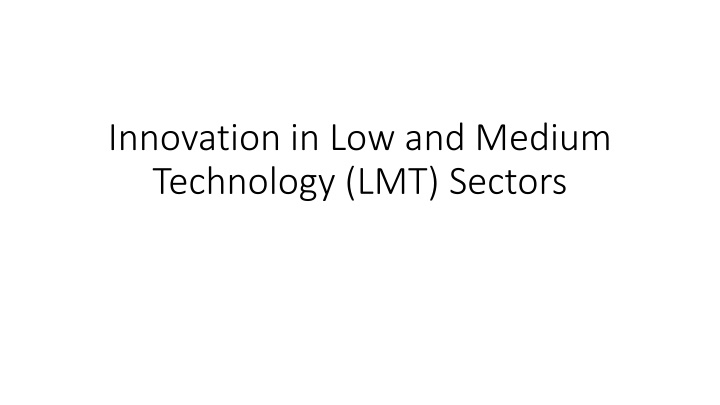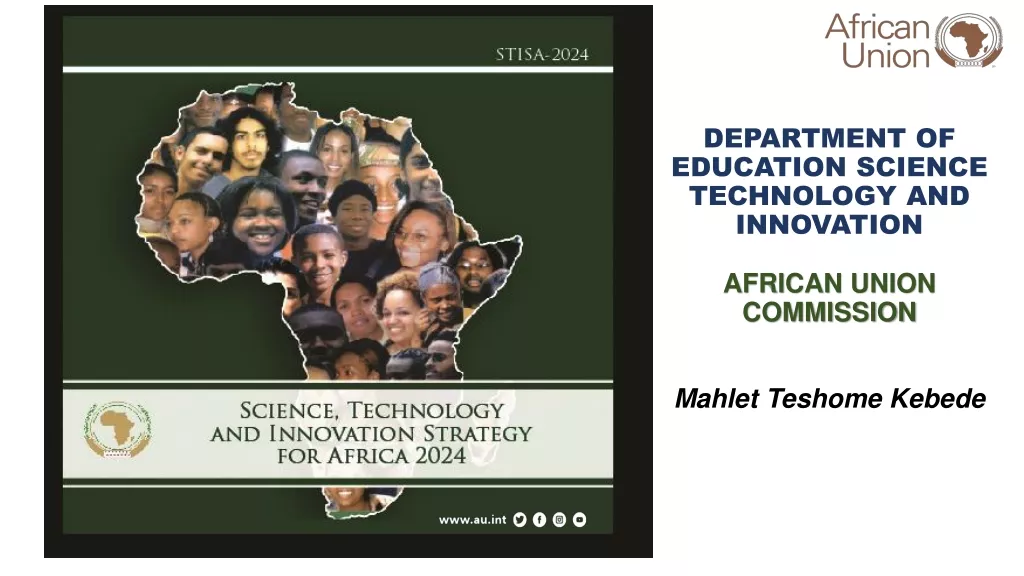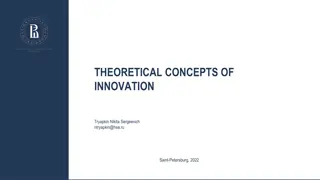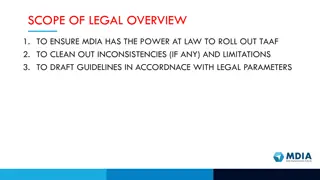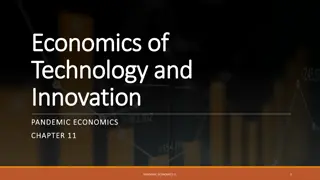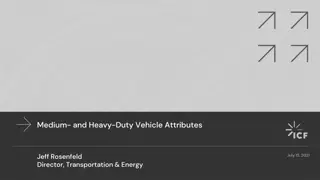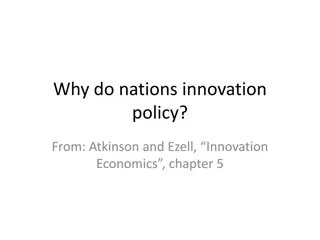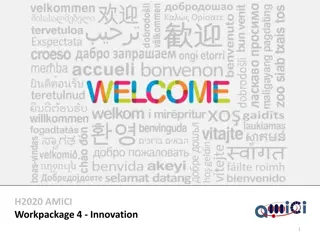Innovation in Low and Medium Technology Sectors
Innovation in Low and Medium Technology (LMT) sectors is crucial for economic growth and development. Explore the impact of innovation in LMT industries and the comparative advantages they offer. Understand the importance of focusing on both high-tech and LMT sectors for sustainable development.
Download Presentation

Please find below an Image/Link to download the presentation.
The content on the website is provided AS IS for your information and personal use only. It may not be sold, licensed, or shared on other websites without obtaining consent from the author.If you encounter any issues during the download, it is possible that the publisher has removed the file from their server.
You are allowed to download the files provided on this website for personal or commercial use, subject to the condition that they are used lawfully. All files are the property of their respective owners.
The content on the website is provided AS IS for your information and personal use only. It may not be sold, licensed, or shared on other websites without obtaining consent from the author.
E N D
Presentation Transcript
Innovation in Low and Medium Technology (LMT) Sectors
Low-tech industrymore than just a matter of semantics It is crucial for understanding where the comparative advantages of countries at varying levels of development may lie. Policy obsession with gaps in high-tech industries has distracted the attention of both policy makers and academics away from making more positive efforts to develop and sustain development in other sectoral direction s which some countries might find more viable. High-tech industries in the OECD account for only about 3 per cent of value- added rising to 8.5 per cent with medium-high-tech industries like car industry Governments need to give more thought to the activities which generate most of the output and employment of their countries and the best targets for dynamic comparative advantage for growth.
Labour and capital The LMT industries are usually regarded as providing many points of entry for developing countries, in view of their relative labor-intensity (e.g. software in India). Some branches of such low-tech industries as food processing are highly capital-intensive (e.g. tobacco and many beverages), as are some branches of building materials (e.g. cement). It also depend on the specific context (es. U.S.A. vs India).
Conventional classification Not just traditional low-tech industries but also those classified by the OECD as medium-tech (= low- and medium-tech , LMT industries.): Mature industries; more slow changes; included non-manufacturing activities (e.g. Oil and Gas); sometimes integrated with services Conventional classifications of sectors as high- or low-tech (etc.), as long practised by the OECD, are becoming less and less useful for academic analysis To be fair, the OECD (2003) came - rightly to place greater emphasis on the knowledge-intensity of industries. Measuring the direct plus indirect technology content of particular industries.
What is a LMT Sector and what innovation in it? Appraising innovation through adopting conventional sectoral classifications can be misleading. Innovation is rapid in particular segments of both high-tech and LMT sectors, (even if more segments of the high-tech sectors display such rapid innovation) It is possible to detach the high-tech segments from LMT industries : e.g. Artificial fibers in textiles when they arose to compete with natural fibers but the final products remain very similar, so this looks specious . .
What are we talking about? Conventionally, sectors of all types were supposed to be different not only in the goods and services but also in the technologies and processes they used to produce them. However The boundaries have blurred over historical time in both dimensions . Technologies originally developed for one set of products spill over into use in the production or architecture of other sets of products. new technologies more often tend to supplement and complement old technologies rather than replace them. even old products can be produced by elements drawn from what had previously been a totally different set of activities (e.g. synthetic fibers in textiles). bundling of goods and services (music on internet)
Another cross-cutting development refers to the blurring boundaries between sectors. In all scenarios with a high innovation dynamic and with growth perspectives, innovation activities are crossing boundaries of sectors . Today the blurring of boundaries become a crucial part of policies towards Industry 4.0, the integration of Cyber-Physical Systems, the Internet of Things and the Internet of Services .
The scenario Green Cars - You can have it All in the automotive sector, is based on blurring boundaries as it does not only integrate technologies form different sectors such as multimedia to create lifestyle products, but it combines transport and energy in the future when batteries of electric cars become power storage devices and part of the electric grid. The blurring of boundaries between sectors is inherent in the concept of technical textiles. Technical textiles are used in sectors such as agriculture, construction, automotive and as protective textiles. At the same time, the textiles industry depends on ICT, on various materials industries (e.g. for nano-structured textiles), etc. The scenario that address an Evolutionary development as well the Breakthrough scenario are based on the ability of the sector to actively cross a variety of sectoral boundaries and to substitute other materials through lightweight textile solution (Fig. 1). Another example of the blurring of boundaries draws on the transformation of the retail and wholesale sector which is expected to have a high leverage effect on related sectors. Similarly, the knowledge inherent in KIBS is a key mechanism interconnecting different sectors; KIBS can be mediators of cross-sectoral developments.
Innovation Innovation drivers in LMT drivers in LMT industries 1) The demand industries The drivers of change as they affect low, medium, and high-tech sectors can be similarly envisaged from the side: 1. of the products (and the demand!) 2. or from the side of the technologies significant differences in interpretation and understanding. Firms hold different interpretative frames , and drivers are particularly important because their well-established markets, necessitate a broader variety of strategic choices for differentiation. Demands change, sometimes slowly but sometimes rapidly and unpredictably, negating attempts to routinize operations and generating turbulence.
A) Demand differentiation: 1) quality innovation and 2) new tastes 1) Quality innovation a) New markets Even older industries can bounce back, by producing for new markets. The same type of goods for untouched regions can work for well-known brands (Coca-Cola) but producing different types of the same categories of good ( product differentiation ) is generally necessary for such resurgence. Low-tech industries face somewhat inelastic demands (many produce comparative necessities, and as consumers attain higher income levels, they have satisfied most of their needs for necessities).
b) New scope for new products (also through technolgy) To stave off this satiation of wants, producers in LMT industries have to find new products to attract the custom of higher earners. The availability of advanced technologies may be an important factor for innovation strategies in LMT firms through dictating the scope for such new products. Even then may not result in products that customers find attractive, as has been the case for genetically modified foodstuffs in some countries. In addition to quality upgrading, consumers may switch their demand patterns to goods which have new characteristics. E.g. Auto/food/Energy: intense pressure from communities and from governments to produce safer and more environmentally friendly items. Adding value in processing (e.g. sensors in tires) Shifts in product mixes to reflect the changing composition of consumers, for example the implications of demographic change (gender relations, ageing, etc.).
What definition definition to be used? Approaches (= classification; taxonomy, etc.) that blend the technology dimension and the product dimension, appear to be: more analytically satisfying better able to account for observed empirical differences between countries and regions better able to account for dynamic paths of industrial evolution over historical time. They need however to be supplemented by technology-oriented distinctions among sectors (e.g. Pavitt taxonomy) to provide a better grasp of the nature of structural change and competitiveness. Furthermore, they are in our view a more advisable platform for policy than simple OECD-style definitions of high- or low-tech.
Science Based Specialized Suppliers Scale Intensive Supplier- dominated
Some problems in defining technology! The majority of manufacturing industries are defined mostly according to their product range but a good number have in common their technologies rather than their products, E.g. biotechnology. - plant biotechnology is regarded as part of the biotechnology industry (technology-defined) or of agriculture (product- defined) makes a big difference to the inferences drawn. Moreover innovation activities in LMT tend to fall outside conventional definition of R&D activities (es. OECD Frascati Manual)
More useful (complex) taxonomies 1) Peneder Peneder (2001): tripartite classification (but starting form Product ) 1. one of his taxonomies rests on factor intensity (mainstream i.e. average; labor-intensive; capital-intensive; marketing-driven; technology-intensive), 2. another on labour skills (low-skill; medium-skill blue-collar; medium-skill white-collar; high-skill), 3. and the third on external service inputs (from knowledge-based services; from retail and advertising services; from transport services; and from other industries).
1b) Peneder Taxonomy Only one of the ninety-nine manufacturing industries Peneder lists ( aircraft and spacecraft ) has the classic high-tech profile of being: technology-intensive and predominantly using high-skill and knowledge-based services! Conversely, there are labor-intensive industries which utilize high skills (e.g. machine tools) and others utilizing knowledge-based service inputs (some branches of metallurgy). His classification underlines the great variety of observable combinations.
2) The Pavit Taxonomy (1984) of sectoral innovation patterns (see also chaptera on SIS) Pavitt (1984) proposes four types of sectoral pattern for innovative activities. I. In supplier-dominated (e.g. textile, services) sectors, new technologies are embodied in new components and equipment, and the diffusion of new technologies and learning takes place through learning-by-doing and by-using. II. In scale-intensive sectors (e.g. autos, steel), process innovation is relevant and the sources of innovation are both internal (R&D and learning-by-doing) and external (equipment producers), while appropriability is obtained through secrecy and patents. III. In specialized suppliers (e.g. equipment producers), innovation is focused on performance improvement, reliability, and customization, with the sources of innovation being both internal (tacit knowledge and experience of skilled technicians) and external (user producer interaction); appropriability comes mainly from the localized and interactive nature of knowledge. IV. Finally, science-based sectors (e.g. pharmaceuticals, electronics) are characterized by a high rate of product and process innovations, by internal R&D, and by scientifc research done at universities and public research laboratories; science is a source of innovation, and appropriability means are of various types, ranging from patents, to lead-times and learning curves,
Difficulties in classifying LMT! Pavitt (and others, as Marsili) deliberately aimed at means of classification that brought together characteristics which certain groups of technologies appeared to share, even though they might pertain to different sectors. Generally this taxonomies do a better job of explaining technological performance than factor content ..However, again, the LMT industries resist easy classification, precisely because many of them are not very distinctive or singular in technological terms. For instance: growing export industries sprinkled all first four categories of Pavitt taxonomy!
3) The Sutton taxonomy: relationships with the industry/market structure Sutton: firms are prepared to spend on marketing their products on the one hand, and on developing their technologies on the other (trad-off) It depends on factors that were partly under a firm s control and partly beyond it! Sutton approach and associated taxonomy can be especially useful for analyzing LMT industries, because supply (technology) is combined with demand (product) aspects in a rigorous way.
Innovation drivers 2) New Technological Paradigms drivers in LMT industries a) General Purpose Technologies and Learning in LMT Firms Key technologies often have the property of being able to become pervasive (they can spill out of their industry of origin and be recruited by older industries) Machinery, steam power, and iron (I Industrial Revolution) information and communication technologies, biotechnology and smart materials in the III IR (= General Purpose Technologies). III IR created new opportunities for LMT industries to enhance their innovative and economic performance through new technologies However, in LMT industries there is usually little formal learning by science and technology, at least at the firm level (innovation and adoption operate in practical and pragmatic ways by doing and using)
The absorptive capacity and the R&D function absorptive capacity has been defined as "a firm's ability to recognize the value of new information, assimilate it, and apply it to commercial ends". It is studied on individual, group, firm, and national levels (https://en.wikipedia.org/wiki/Absorptive_capacity) ** The bulk of the general-purpose technologies, are developed by separate companies (rarely subsidiaries), specialized in the relevant technological fields. However the downstream LMT industries ( users ) need to have absorptive capacities to make productive use of these upstream developments. food-processing companies involved in advanced ( third-generation ) biotechnology do not carry out much of the associated research themselves but are often prominent in patenting in less advanced ( second-generation ) biotechnology this seems to provide them with the necessary absorptive capabilities. Formal science may congregate in national or regional laboratories in such industries, instead of being internalized within firms Innovation require firm-specific absorptive capacities, generated not just from formal R&D but from broader-based innovative activities that include engineering, continuous improvement processes, and organizational innovations such as integrated service and supply.
Carrier Industries (general purpose techn.) Economists have come to use the term general purpose technology (GPT) to describe technological advances that pervade many sectors, improve rapidly, and spawn further innovations (e.g. Steam Engine!). ** Describing one particular industry supplying technologies, namely machine tools, Rosenberg (1963) showed how the number of different types of tools was quite limited and as a result their principles could readily be stretched to being applied in industries other than where they were first deployed. Signifcant role of carrier industries, which incorporated these proliferating machine tools into making the machines they produced or used (producing machines related to those tools ). general purpose technologies : any industry can act as a carrier if its demand for the new capital good is large enough or growing fast enough. Thus even low-tech sectors can act as receptors for new process-oriented technologies (e.g. machine tools for 3d printers).
Research in LMT industries. Knowledge search, identification and proof, rather than basic research, are likely to be of particular importance to innovation in the non-manufacturing activities of LMT industries. We have to ask what part of each industry we are characterizing as high- or low-tech when considering their growth potential advantage In low-growth sectors (such as processed foods) innovation lies towards the high-tech end of these low-growth sectors (like applying biotechnology to food processing).
E.g. The tire industry E.g. Tire industry - Sunk costs; heavy market concentration; Capital intensive; large scale; not strong changes in basic technology (rubber) Global Oligopolistic structure! Technology is applied by the tire manufacturers to reduce costs, to differentiate the product line and to focus on greater value-adding activities (Acha and Brusoni 2003). Complexity in the nature of Knowledge Basis; Interface between chemical knowledge base (rubber) and others (sensors, electronics, car engineering, etc.) Facing a global market where it is more and more difficult to make a profit, the leading manufacturers are continuously focusing on reducing costs through reducing throughput and labor costs (including the long-awaited introduction of robotics), innovations in processing technologies and source product (a new polyurethane tire polymer), and in the method itself (e.g. sensors in tires). Beyond influencing the cost and ease of production, tire manufacturers have invested in research and technology to also help them to move away from the commodity trap, where products can only compete on price. (e.g. also marketing: colored tires!). Or moving up the value chain by manufacturing entire tire assembly systems. High-tech providers; Patents; High R&D rates
Fi r m s a n d Co r p o r a t e Fi r m s a n d Co r p o r a t e Ch i i n L M T In d u s t r n L M T In d u s t r i i e s = Issues concerning strategies and structures at the firm level (economies of scale and scope; vert./horiz. Integration) in both large firms and SMEs: relations with technologies and innovation processes Ch a n g e a n g e e s STRATEGIES A) orthodox vision Porter (1985) : three main types of corporate strategy, namely: a) cost leadership, b) differentiation; c) focus. cost leadership is the likely choice of firms in a mature LMT industry (process innovation only to pare down costs even) . B) Alternative points of view: technology related also to . Branding (product reputation) is often crucial to the choice of a differentiation strategy (e.g. Skoda is nowadays using advertising of its new technologies to change deep-seated customer prejudices); Focus in terms of multidivisional firm (many focused markets): it may rise several problems (if there are spillovers between the same functions located in different divisions)
